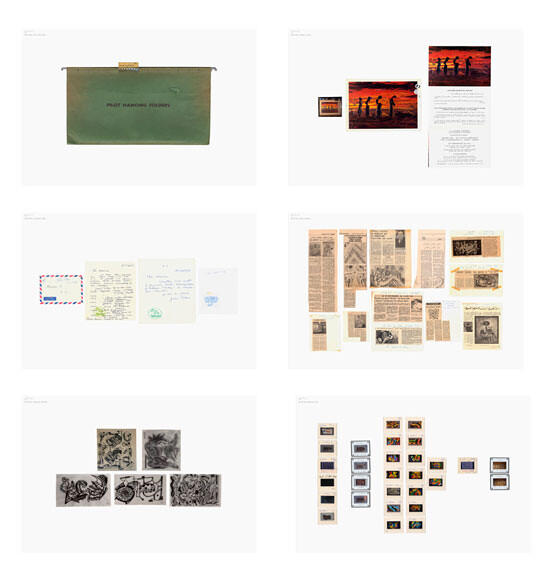If you look closely, you can see the white lines on this fragment of wall.
And those who read Arabic can tell that these lines are actually letters and names. These are the names of men and women who have lived and worked in Lebanon as painters and sculptors over the past century. They are also the names that I have been receiving telepathically from artists in the future over the past nine years.
If, like me, you have experienced telepathic reception, then you know that you can never trust telepathic signals, because telepathic signals are always accompanied by something else. They are always accompanied by telepathic noise. That’s why I usually need some kind of confirmation that the signals are indeed telepathic, and possibly from the future. To do this, I readied an exhibition space in Beirut and displayed these names in white vinyl letters on a continuous white wall (which was not broken as you see it here—we broke it up in order to transport it) and I told myself that confirmation would come—somehow, sometime. And I should let you know that when I look for confirmation for telepathic signals, I usually seek it from artists, writers, dancers, and cooks.
What I did not expect was for this confirmation to come to me from the least sympathetic person I could think of: a local cook who considers himself a guardian of Lebanese modern and contemporary art.
The cook walked into my room and immediately proceeded to disregard my telepathic claims as a fanciful contemporary conceptual conceit. Moreover, he unequivocally confirmed to me that the names displayed were those of “artists” who have lived and worked in Lebanon in the past century. “But,” the cook said, “many of the names are misspelled.”
“Of course,” I said. “Telepathic noise.”
He was unwilling to attribute my orthographic errors to telepathic noise. He said: “This is typical of your generation, this postwar generation of artists. Not only are you unable to even spell the names of anyone who came before you, more importantly, you always ignore their contributions.”
Finally, the cook was most indignant at the fact that, of all the names I could have misspelled, I casually misspelled the name of an “artist” who deserved it the least, an “artist” who’d spent a good part of his adult life wheelchair-bound: Johnny Tahan. “Hasn’t this man suffered enough in life? Must he suffer again at your hands?” said the cook. And then, with red spray paint and on my beautiful clean white walls, the cook took it upon himself to “correct” the misspelled names.
This shattered me. It hurt me. Not because I care about the cook and his opinion, but because I did not want to contribute to the suffering of Johnny Tahan. I also immediately knew that I needed to find out everything I could about Tahan: Who was he? What kind of work did he do? Is he still alive? Where are his paintings and drawings? So I spent the next two years talking to his friends, acquaintances, and relatives, tracking down his works and other documents related to his life.


And I found out that Johnny Tahan was born in Egypt in 1930 and died in Beirut in 1989. I found copies of his drawings and paintings. I found reproductions of his works, his slides. I found reviews of his various exhibitions in Lebanese newspapers. In one of the reviews, there was even a photograph of him in a wheelchair. Yes, the cook was right. Tahan did spend the majority of his life in a wheelchair. I found price lists and correspondence with collectors and other artifacts. In other words, after two years of research I found enough documents to be able to say that Johnny Tahan was, well, let’s not call him an artist. Let’s say he was someone who painted and drew; he exhibited his works; he sold them; he lived in the second half of the twentieth century in Beirut. He is an historical figure and his name certainly deserves to be spelled correctly.
But still, there was something unconvincing, something that seemed deceptive about the cook’s indignation and his call for compassion. And over time, I came to view this indignation as a ruse distracting me from a scenario more insidious than merely ignoring a predecessor and misspelling his name.
I am now convinced that it was the artists from the future who did it on purpose. I am convinced that artists from the future purposely distorted Tahan’s name when they communicated it to me via telepathy because artists from the future are not first and foremost hailing Tahan. They are not intent on launching me on some corrective historical mission, to fill the gaps in my artistic knowledge. Future artists want or need something else. And today I know what they want or need.
Future artists want or need a color. More precisely, they want or need this particular shade of red that appeared in the cook’s sprayed “corrections.” But why would future artists want or need this color? Is it because it is no longer available to them? But why would this color be no longer available to them? Has there been a major nuclear disaster sometime in the future that depleted or destroyed the pigments that compose the color? No, the pigments, in fact, remain quite abundant.
The color is not available to the artists of the future because the color has been affected. But it has not been affected physically and materially. No. It has been affected immaterially.
This sudden realization brought me face to face with something I had never, ever considered about the protracted Lebanese wars.
(To be continued.)

